AI-Driven Personalization: Top Trends to Boost Success
The Future of Customer Experience is Here
AI-driven personalization is changing how brands connect with their audiences by delivering custom experiences based on individual preferences, behaviors, and data. Instead of generic one-size-fits-all approaches, AI enables truly customized interactions that evolve in real-time.
“When you think of the (overused) phrase ‘people-first’, you’re probably not going to think of AI first – but when it comes to truly personalized marketing, AI is the secret ingredient you can’t afford to ignore.”
For those looking to understand AI-driven personalization quickly:
| What is AI-Driven Personalization? | Key Benefits | Implementation |
|---|---|---|
| The use of artificial intelligence to analyze customer data and deliver custom experiences in real-time | • Up to 800% ROI on marketing spend • 10-30% increase in conversion rates • Improved customer satisfaction |
• Uses machine learning algorithms • Adapts continuously to user behavior • Works across multiple channels |
AI personalization goes far beyond simply addressing customers by name in emails. It leverages sophisticated algorithms to:
- Predict customer needs before they arise
- Dynamically adjust content based on real-time behavior
- Create truly unique experiences for each user
- Scale personalization efforts that would be impossible manually
The data speaks volumes: 76% of consumers get frustrated when personalized interactions don’t happen, and businesses using AI personalization are seeing 5-8 times the return on marketing spend.
I’m Samir ElKamouny AV, an entrepreneur and marketing expert who has helped numerous businesses implement AI-driven personalization strategies that transform customer experiences and drive measurable growth. Throughout this guide, I’ll share actionable insights to help you leverage this powerful technology for your brand.
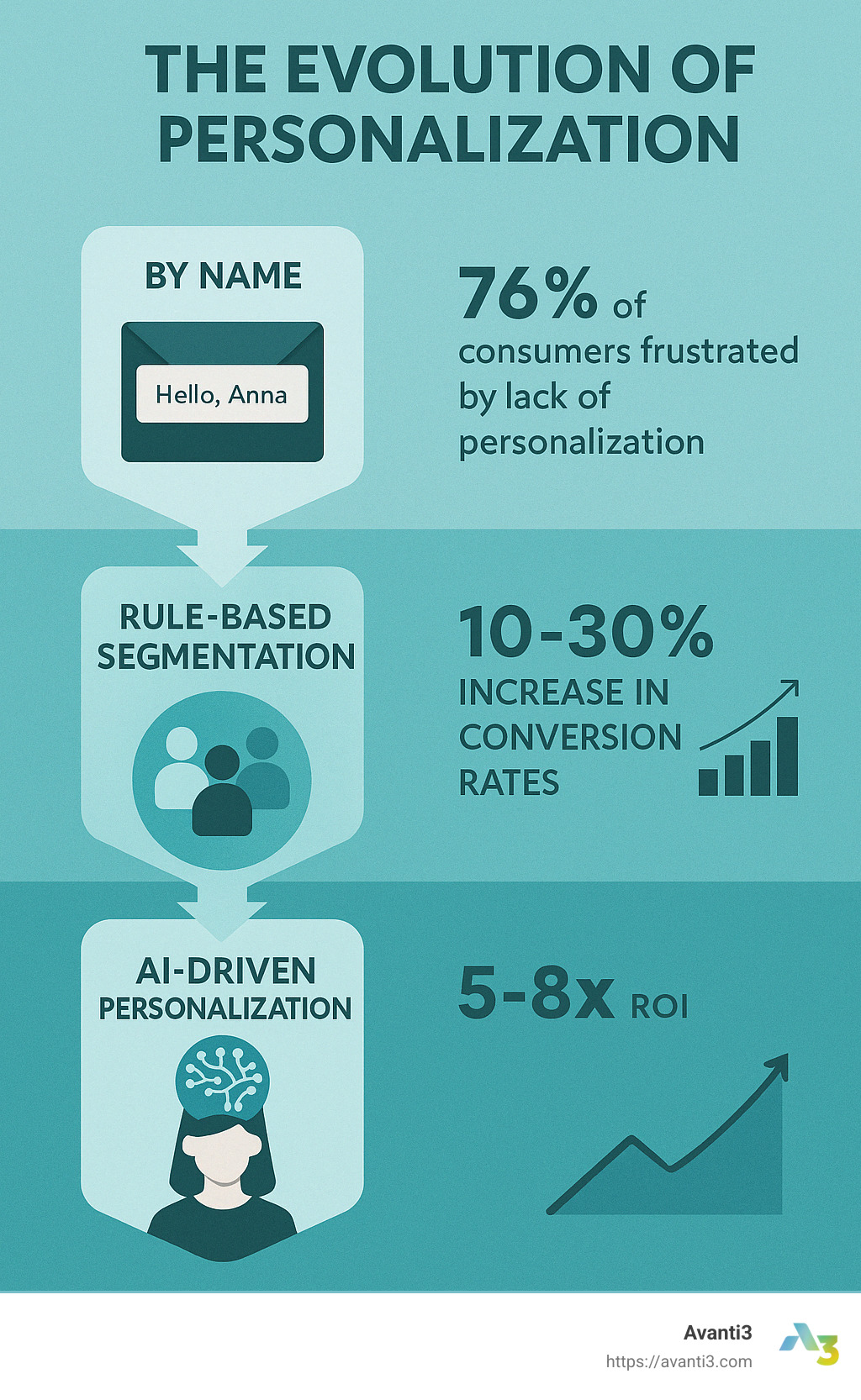
What is AI-Driven Personalization?
AI-driven personalization is all about using artificial intelligence to deliver truly customized experiences to your customers. Think of it as the difference between a friendly shopkeeper who knows exactly what you want, versus a generic salesperson who simply follows basic rules. AI-driven personalization goes beyond simple segmentation and rules-based approaches—it’s like having a super-smart assistant who learns about each customer individually, constantly improving how well they understand each user’s preferences.
At its heart, AI-driven personalization relies on powerful machine learning algorithms. These algorithms analyze massive amounts of customer data to uncover hidden patterns, understand interests, and even predict what someone might want next. Natural language processing helps AI understand customer intent and sentiment—so it doesn’t just know what customers click on, but also understands why they’re clicking. Predictive analytics further sharpen this understanding, allowing businesses to anticipate customers’ future needs and desires before they even realize them.
Unlike traditional personalization—which relies on simple rules like, “if they bought shoes, show them socks”—AI-driven methods use deep learning models that continuously adapt and improve as they interact with more users. It’s like your own personal marketing team that keeps getting smarter every day.
Ted Sarandos from Netflix said: “Our brand is personalization.” And he’s not kidding—Netflix is a great example of AI-driven personalization, powering personalized movie and TV show recommendations that keep you binging late into the night (we’ve all been there).
But how exactly does AI-driven personalization figure out what customers really want? It analyzes a range of data points—everything from past purchase history and browsing behavior to the amount of time someone spends viewing specific content. Click patterns, demographic information, context (like time of day, location, or device used), and even social media activity all play a role.
What’s truly impressive about AI-driven personalization is how it processes all these diverse data points simultaneously and instantly. It spots connections humans might never notice, delivering hyper-relevant experiences in real-time that people actually enjoy.
In short, AI-driven personalization helps brands move from generic, one-size-fits-all messaging to highly custom experiences that customers love. And as we’ll see throughout this guide, businesses leveraging AI personalization are enjoying bigger returns, happier customers, and stronger brand loyalty.
How AI-Driven Personalization Differs from Traditional Methods
If you’ve ever browsed online for new shoes and ended up seeing shoe ads everywhere—weeks after you’ve bought them—you’ve already experienced the downside of traditional personalization. While well-intentioned, older approaches rely heavily on manual rules and static segments. Let’s explore how AI-driven personalization takes things up several notches.
Rules-Based Personalization
Traditional personalization typically uses a simple, “if-this-then-that” approach. Marketers manually set rules based on straightforward actions or demographics. For example, “If someone lives in New York, show them promotions for local events” or “If someone buys baby diapers, display ads for baby wipes.”
These rules sound good at first, right? But as your customer base grows—and as their behaviors become more complex—managing these rules becomes overwhelming. More variables mean more manual work, and soon you’re juggling hundreds of conditions. As one marketer humorously put it, “After someone buys a washing machine, they don’t want washer ads chasing them around the internet for weeks!”
Limitations of Traditional Methods
Apart from being annoying, traditional methods have several key limitations that stop them from being truly personalized. First, scalability becomes a real headache. As you add more customer segments and more rules to handle them, the system gets messy—and fast.
Second, these rules-based methods are static. This means they can’t automatically respond when a customer’s behavior or interests change. You have to wait until someone notices the mismatch and manually fixes it—often after your customers have already lost interest.
Additionally, traditional methods can only handle limited data processing. Humans can only realistically analyze a small fraction of available customer data, meaning you’re missing out on crucial insights that could improve the customer experience. Plus, without predictive capabilities, your personalization stays reactive rather than proactive, always a step behind the customer’s actual needs. All this makes traditional methods incredibly labor-intensive, requiring constant manual tweaking and oversight.
Real-Time Data Processing
Here’s the good news: AI-driven personalization solves all these issues and does so neatly. Instead of relying on static rules, AI systems use real-time adaptation. They can instantly recognize shifts in customer behavior, interests, or preferences and adjust your content accordingly—no human intervention needed.
AI can process massive amounts of customer data simultaneously, finding patterns and insights that would be invisible to human eyes. With advanced pattern recognition, it identifies subtle connections between behaviors that traditional methods can’t even see.
Moreover, AI-driven systems use continuous learning algorithms. That means they don’t just adapt once—they keep refining their personalization strategy over time, getting smarter and more accurate as they gather more customer interactions.
Finally, predictive capabilities allow AI to anticipate what your customers want—even before they realize it themselves. By analyzing similar patterns across thousands or even millions of customers, AI-driven personalization offers proactive recommendations that genuinely delight users.
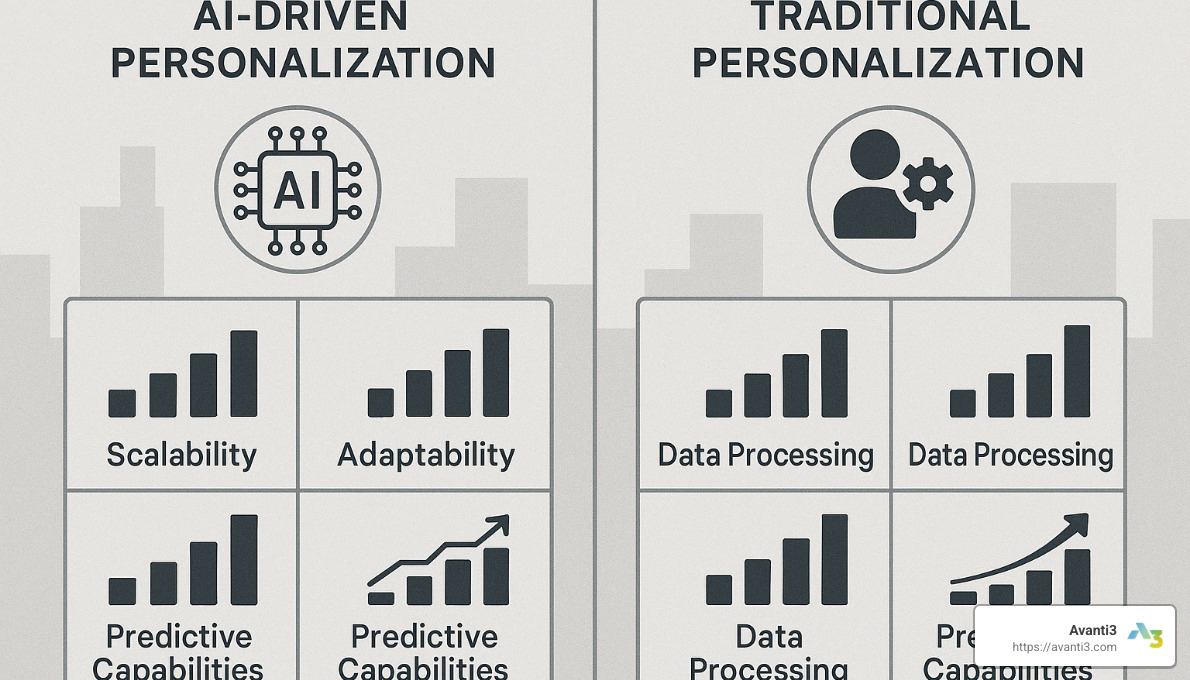
As our research highlights, “AI-driven personalization is not just about automated recommendations but involves adaptive, real-time learning that continuously refines user profiles based on behavior and context.”
Simply put, AI-driven personalization is the smarter, more dynamic, and far more scalable solution for brands looking to deliver experiences that customers actually enjoy—and remember for all the right reasons.
The Importance of AI in Delivering Personalized Experiences
Today, customers are flooded with choices. Standing out in this crowded marketplace means delivering memorable, personalized experiences that speak directly to each individual’s preferences and needs. And that’s exactly where AI-driven personalization shines.
Businesses are catching on quickly—92% now use some form of AI personalization to fuel their growth. This isn’t just a trend; it’s become an expectation. A remarkable 71% of consumers say they expect personalized interactions. And when brands miss the mark, 67% of customers feel frustrated.
That’s why AI isn’t just a buzzword—it’s essential for staying competitive and relevant.
AI’s powerful capabilities allow it to transform customer experiences at scale, something traditional methods simply can’t match. AI can rapidly process massive amounts of data—far beyond human ability—at lightning-fast speeds. It effortlessly manages the complexity of juggling countless variables for millions of unique users.
Better yet, AI doesn’t just automate personalization—it continuously learns and improves. With every click, every interaction, every purchase, AI algorithms grow smarter, fine-tuning their accuracy and relevance. This adaptive nature means your customers’ experiences become more personalized and meaningful over time.
The measurable impact of AI is impressive, too. According to McKinsey research, companies that excel at personalized customer experiences enjoy 40% more revenue growth compared to slower adopters. That’s a serious competitive advantage you can’t afford to overlook.
AI-Driven Personalization Improves Customer Satisfaction
Happy customers are loyal customers. And when it comes to customer satisfaction, personalization matters—a lot. A full 76% of customers say they expect personalized experiences from brands, and when they get them, they respond enthusiastically.
In fact, 86% of customers are willing to pay more for a great customer experience, and 77% actively choose brands that offer personalized services. By tailoring interactions to customers’ individual tastes and behaviors, businesses build stronger emotional connections and foster lasting loyalty.
One fascinating insight from our research is that “AI can sometimes understand customers even better than they understand themselves.” Sounds surprising, right? But think about it: AI analyzes countless behavioral patterns to uncover subtle preferences that customers themselves might not consciously recognize. That means more relevant recommendations, more engaging interactions, and happier customers.
ROI and Conversion Rate Improvements
If customer satisfaction alone isn’t convincing enough, consider the numbers: AI-driven personalization delivers exceptional returns.
Companies leveraging AI personalization often see up to 800% ROI on their marketing spend. E-commerce businesses commonly report conversion rate improvements of 10-30% after implementing personalized recommendations and dynamic content.
These are more than just numbers on a spreadsheet—real brands are seeing real results:
- One retail brand saw a 33% boost in conversions by implementing AI-powered product recommendations.
- An email campaign using AI personalization achieved transaction rates six times higher than non-personalized campaigns.
- A digital marketing campaign with AI-driven ad targeting witnessed a 31% increase in purchases.
As Kevin Johnson noted in our research, “Our AI-powered app suggestions boosted average order value by 17% in just three months.” It’s clear that personalized experiences don’t just make customers happy; they boost your bottom line, too.
At Avanti3, we understand the power and potential of AI-driven personalization. By integrating cutting-edge technologies like AI, blockchain, AR/VR, and NFTs, we help brands create unforgettable, personalized experiences and build vibrant communities. To learn more about enhancing customer experiences through AI, check out our page on AI Customer Engagement.
When you accept AI-driven personalization, you’re not just keeping up with the times—you’re building stronger relationships with your customers, driving loyalty, and setting your business up for sustained growth.
How AI Uses Adaptive Learning in Real-Time Personalization
One of the most remarkable qualities of AI-driven personalization is its ability to adapt instantly to each customer’s unique preferences and behaviors. Think of it like a friendly shopkeeper who remembers your favorite items and anticipates exactly what you’re looking for. Except in this case, the shopkeeper is an incredibly smart algorithm, working tirelessly behind the scenes.
Instead of using rigid, pre-set rules, AI personalization learns from every interaction a customer has with your brand. Each click, scroll, or pause tells a tiny story about their preferences. The AI collects these stories—also known as data—and continuously refines its understanding. It spots patterns, updates its models, and improves recommendations on the fly. This real-time adaptation creates personalized experiences that become more relevant and engaging with every visit.
It’s a bit like Netflix noticing you’ve suddenly developed a fascination with baking shows, so it immediately serves you more delicious content. Or Amazon realizing your recent interest in photography and quickly highlighting cameras and photography guides on your homepage. This adaptive learning creates a seamless feedback loop: the more customers interact, the smarter the personalization becomes.
Predictive Analytics and Machine Learning Benefits
But how exactly does AI know what’s next? Enter predictive analytics and machine learning. These powerful tools analyze enormous amounts of customer data to identify patterns and predict future actions.
For example, AI can deliver anticipatory recommendations, suggesting products or content before customers even realize they want them. Imagine your favorite coffee shop noticing you’re regularly buying coffee beans and proactively sending you a discount on your preferred roast right as you’re about to run out.
AI-driven personalization also excels at behavioral prediction, helping brands understand how different customer groups will respond to certain marketing strategies. This allows businesses to craft messaging and offers that resonate deeply with each individual.
Another strength lies in anomaly detection: AI quickly spots unusual shifts in behavior, signaling a change in customer interests or preferences. This helps brands stay responsive and relevant even as consumer tastes evolve.
Additionally, AI uses sentiment analysis to gauge emotional reactions. By understanding whether customers feel positive, neutral, or negative about interactions, brands can optimize experiences and messaging.
Finally, AI can quickly identify emerging trends across user groups, ensuring brands stay ahead of the curve and offer fresh, timely experiences.
As our research puts it: “AI’s ability to anticipate customer behavior through machine learning models transforms personalization from reactive guesswork to proactive relationship-building.”
Examples of Real-Time Personalization
Let’s walk through some real-life scenarios to see adaptive learning in action:
The Evolving Homepage:
Say Kerry from Seattle lands on an ecommerce site, checking out athletic gear. The AI quickly sees she’s spending extra time on running shoes and reading lots of reviews. Instantly, the homepage starts showing more running products and related content. When she returns a few days later, the homepage still remembers her interests, greeting her with personalized promotions just for runners.
The Contextual App:
Alex, an avid gamer, often browses an app in the evenings. The AI notices his nighttime habit of exploring gaming accessories. Soon enough, his nightly visits are filled with personalized gaming deals and product suggestions, while daytime sessions show him other relevant categories instead.
The Learning Email Sequence:
John, a busy parent, opens an email about kids’ toys but quickly steers to outdoor trip gear instead. Taking note, the AI adapts the content of future emails, emphasizing outdoor family activities rather than indoor toys. John feels understood, engaged, and more likely to stay connected.
Real-time adaptive learning makes customers feel truly seen and understood, providing precisely custom experiences at every interaction. This level of personalization isn’t just powerful—it’s becoming an expectation from customers in today’s marketplace.
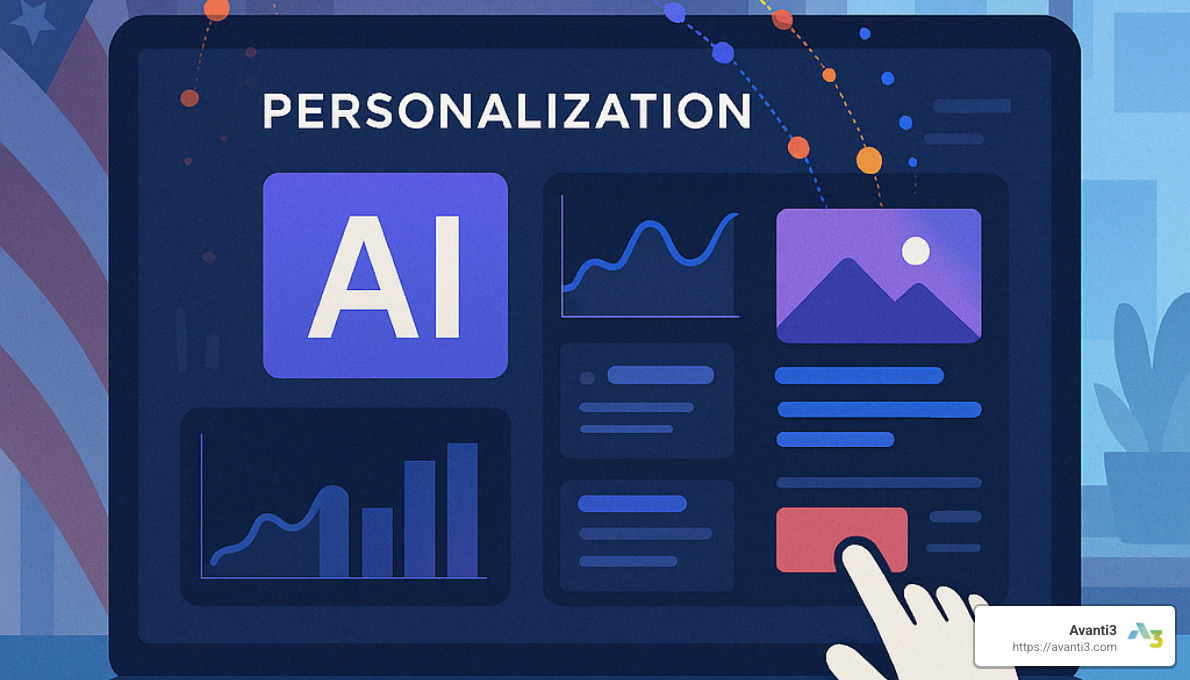
Examples of AI-Powered Personalization Across Industries
Across nearly every industry, businesses are using the power of AI-driven personalization to transform customer experiences. From shopping online to the healthcare you receive, AI is reshaping the way brands engage their audiences—making interactions more meaningful, relevant, and enjoyable. Let’s explore how various sectors are using AI personalization to deliver impressive results.
Ecommerce: Personalized Product Recommendations
Online shopping was one of the earliest industries to accept AI-driven personalization, and with good reason—the results speak for themselves.
Consider this: Amazon’s recommendation engine alone drives around 35% of its total sales. That’s huge. In fact, when you offer customers personalized product recommendations, studies show average order values can jump up by as much as 50%. And according to McKinsey’s research, 67% of first-time buyers consider these relevant suggestions extremely valuable.
Today, ecommerce AI isn’t limited to the familiar “customers who bought X also bought Y” prompts. It’s evolved to include more sophisticated methods, such as visual-search tools that help you find products visually similar to what you’re already viewing, or complementary product suggestions that intuitively pair items together (think running shoes and athletic socks). It can even predict when you might run out of your favorite shampoo, sending timely reminders to reorder.
Some brands are also using AI to personalize pricing offers, recognizing individual price sensitivity to maximize both customer satisfaction and profitability. Others dynamically reorganize product pages based on your previous browsing behaviors, making your shopping journey smoother and more intuitive. One retailer we spoke with saw conversion rates jump by 33% after introducing AI-driven recommendations—proof of how impactful this technology can be.
Entertainment: Customized Content Delivery
Streaming platforms like Netflix and Spotify show just how powerful personalized entertainment experiences can be. At Netflix, about 80% of all views come from personalized recommendations rather than manual searches. Spotify, meanwhile, uses AI to create incredibly specific, personalized playlists based on your listening habits—whether you’re looking for “songs to serenade your cat” or your ultimate running motivation mix.
What’s fascinating (and a little humorous) is how accurate these recommendations can be—even when they seem unusual. By analyzing user behavior and preferences deeply, these platforms strike that perfect balance between introducing fresh content and providing comforting familiarity.
As Russell John Weiner from Domino’s Pizza joked about predictive analytics, “We make pizzas before people order them.” The same logic applies seamlessly to digital entertainment, allowing streaming services to anticipate the shows, movies, or music you’re likely to enjoy next before you even click play.
Finance: Personalized Financial Advice
AI personalization is also making waves in the financial sector, improving both customer engagement and financial wellness. Banks and fintech companies now provide customized financial insights based on your unique spending habits and financial behavior. If you’re overspending in one area, or missing savings opportunities, AI-driven tools proactively offer suggestions custom to your specific needs.
Investment platforms leverage AI to recommend portfolios finely tuned to your risk tolerance, financial goals, and life stage. Insurance providers offer customized coverage options, while advanced fraud detection systems continuously learn your personal spending patterns, quickly spotting any suspicious or irregular activity.
Crucially, these personalized financial experiences rely on secure data handling, combining multiple sources of information—from your transaction history to major life events like buying a home—to offer advice that genuinely matches your individual situation.
Healthcare: Custom Patient Experiences
In healthcare, personalization isn’t just convenient—it can be life-changing. Healthcare providers increasingly use AI-driven personalization to tailor treatments to a patient’s personal health history, genetic background, and lifestyle. This means patients receive customized health reminders, custom wellness advice, and timely education materials specific to their medical conditions.
Predictive analytics in healthcare also helps doctors pinpoint patients who might be at risk for certain complications, proactively delivering preventive care. For example, a person at risk of diabetes complications might receive targeted diet and lifestyle recommendations custom exactly to their needs.
One healthcare provider explained it simply: “AI personalization lets us deliver the right information to patients at exactly the right moment in their healthcare journey.” In this context, AI-driven personalization isn’t just about creating a great customer experience—it’s about supporting better health outcomes and improving lives.
Challenges in Implementing AI-Driven Personalization
Implementing AI-driven personalization can deliver extraordinary results, but it isn’t without its problems. Let’s talk honestly about what these challenges look like—and how your organization can overcome them.
Ensuring Data Privacy and Security
One of the biggest concerns businesses face when implementing AI-driven personalization is safeguarding customer data. With regulations like GDPR and CCPA in place, compliance isn’t optional—it’s mandatory. Ensuring your AI systems respect data privacy means paying close attention to regulatory compliance. You’ll need to steer these rules carefully to avoid hefty fines and maintain customer trust.
To keep data secure, businesses should collect only what they truly need. Minimizing data collection doesn’t just protect your customers—it simplifies management and reduces risks. Additionally, having a clear consent management strategy is crucial. Customers need to know precisely what data you’re collecting, why you’re collecting it, and how you’ll use it. Transparency builds trust, and trust is essential for successful personalization.
Protecting sensitive information through robust data encryption methods is another necessity. With strong encryption, even if breaches occur, the data remains safeguarded and unreadable. Finally, clearly communicating your data policies and how you use customer information for personalization puts everyone at ease. Transparent policies aren’t just ethical—they’re good for business.
As our research consistently shows, prioritizing user consent and transparency while offering clear opt-out options are essential to ethically implementing AI-driven personalization.
Taking a “privacy by design” approach—embedding privacy protections deeply into your personalization strategy from day one—will help you avoid headaches down the line.
Overcoming Technical Challenges
Technical complexities often hold businesses back from fully embracing AI-driven personalization. One major obstacle is data integration. Most companies have data scattered across multiple systems—CRM tools, email platforms, social media, and more. Bringing all that data together into a unified customer profile can feel overwhelming, but it’s essential for truly personalized experiences.
Choosing the right AI algorithms is another big decision. There’s no “one-size-fits-all” AI model. Each use case requires careful consideration and testing to find what works best. And once you’ve selected your algorithms, ensuring scalability becomes critical. Your personalization systems must be able to grow smoothly as your customer base and data volumes expand.
Real-time processing is also key for AI-powered personalization to truly shine. Customers today expect instant, relevant experiences. Delayed recommendations or outdated suggestions simply won’t cut it in today’s digital landscape.
Integrating AI smoothly into your existing technology stack is a common stumbling block. Most organizations have legacy systems in place, and getting AI solutions to play nicely with older technology isn’t always easy. As one tech expert humorously (but truthfully!) noted, “The challenge isn’t just implementing AI—it’s making it work seamlessly with your existing marketing technology stack.”
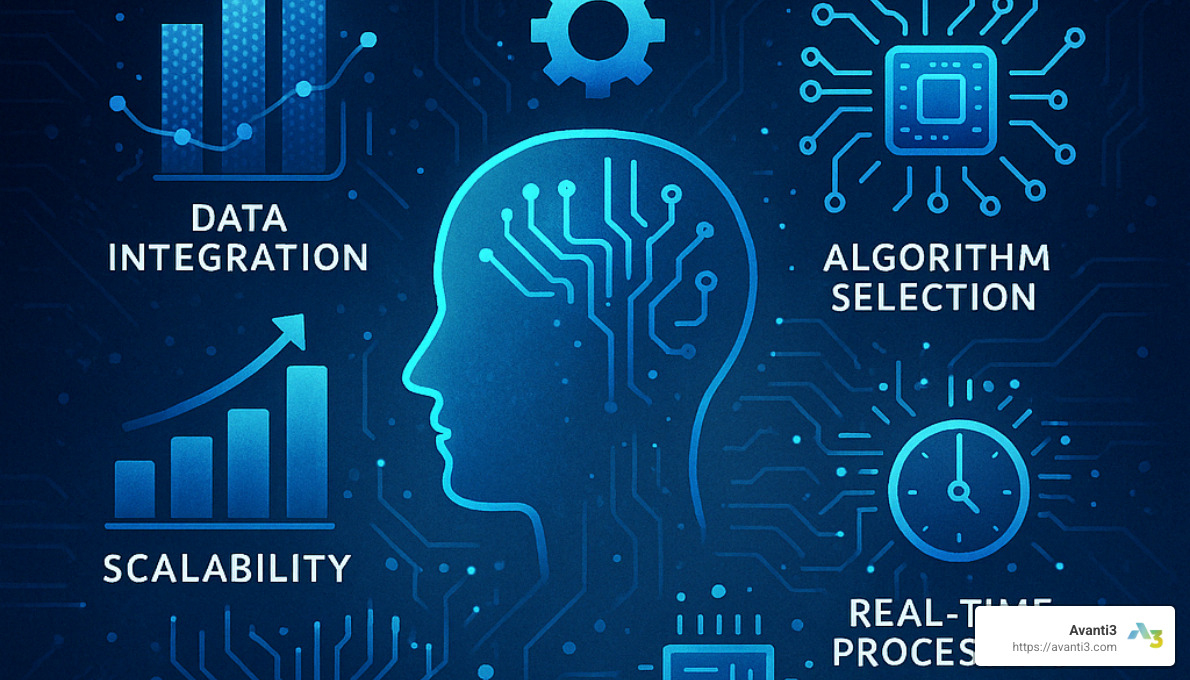
Resource Requirements
Let’s be real: adopting AI-driven personalization isn’t a small undertaking. It demands significant resources, starting with talent. You’ll need data scientists, personalization experts, and AI specialists—skills that aren’t always easy to find or retain.
Technology investments are another major consideration. You’ll need AI platforms, robust data storage solutions, and powerful processing capabilities to handle the heavy lifting. And these aren’t typically cheap.
Time also plays a big role. AI-powered personalization rarely delivers instant results. Machine learning models need adequate training periods to learn from data and interactions before they start performing at their best.
Lastly, the budget factor can’t be ignored. AI personalization comes with upfront investment costs, plus ongoing maintenance and optimization expenses. While initial investments can be high, the good news is that effective AI-driven personalization usually pays for itself over the long run through improved conversion rates, customer satisfaction, and higher ROI.
Comparison: Traditional vs. AI-Driven Personalization Challenges
To give you a clear picture, let’s briefly compare traditional methods with AI-driven personalization when it comes to challenges:
| Challenge Area | Traditional Personalization | AI-Driven Personalization |
|---|---|---|
| Scalability | Limited by manual rule creation | Can scale to millions of individual experiences |
| Data Integration | Typically uses limited data sources | Requires comprehensive data integration |
| Implementation Complexity | Moderate technical requirements | High technical complexity |
| Maintenance | Constant manual updates needed | Self-improving but requires monitoring |
| Privacy Concerns | Manageable with basic practices | Requires sophisticated privacy frameworks |
| Cost Structure | Lower initial investment, higher ongoing labor | Higher initial investment, lower long-term costs |
Yes, implementing AI personalization requires effort and investment upfront—but the rewards are worth it. At Avanti3, we’ve seen how businesses that carefully tackle these challenges can open up impressive growth and customer engagement through AI-driven personalization.
Best Practices for Integrating AI-Driven Personalization
Integrating AI-driven personalization into your marketing and customer experience strategy can boost your results dramatically—but only if you approach it thoughtfully. Let’s explore some best practices to help you smoothly transition into effective AI personalization.
Set Clear Goals and Metrics
First, it’s crucial to clearly define your objectives. Before diving into AI-driven personalization, ask yourself:
- What specific business outcomes do I want to achieve? Are you aiming to improve conversion rates, increase average order values, or improve customer loyalty?
- How will I measure success? Identify clear Key Performance Indicators (KPIs) to track progress effectively. Popular metrics include conversion rate improvements, customer lifetime value (CLV), average order value (AOV), and engagement metrics like time spent on site or pages viewed per session. Don’t forget softer metrics like customer satisfaction scores or Net Promoter Score (NPS)—these matter too!
Having clearly defined goals ensures everyone understands what’s expected and helps your team stay aligned as you implement and refine your personalization strategies. As our research clearly shows, “Define clear objectives and milestones for personalization strategies.” Without concrete goals, you’ll have a tough time knowing if your efforts are truly paying off.
Choose the Right Tools and Technologies
Picking the right technology stack is another essential step for AI-driven personalization success. To effectively deliver personalized experiences, your tech toolbox should include a connected data platform that brings together diverse data sources into a single, unified view. A robust AI personalization engine, custom specifically to your business needs, will analyze this data to accurately predict customer preferences and behaviors.
Additionally, a Customer Data Platform (CDP) helps you manage unified customer profiles and maintain up-to-date information. For instant personalization adjustments, use a real-time decision engine that can quickly adapt to user signals as they happen. Finally, don’t forget solid analytics tools to measure and optimize personalization performance—after all, you can’t manage what you can’t measure.
One expert shared a helpful tip during our research: “Invest in a robust and clean data infrastructure to support AI personalization. It saves headaches down the road!”
Aligning AI-Driven Personalization with Marketing Strategies
To maximize impact, ensure your AI-driven personalization aligns seamlessly with your broader marketing strategy. Begin by mapping out your customer journey to identify critical touchpoints where personalization can significantly improve user experiences.
Keep your messaging consistent across all personalized content—customers should feel a genuine connection with your brand voice at every interaction. Cross-channel integration ensures customers receive a harmonious experience whether they’re on your website, social media, or app.
Also, design your content strategy to be flexible and adaptable for personalization, making it easy to dynamically tailor your message to various customer segments. Put in place a robust testing framework (such as A/B testing) so you can clearly evaluate and optimize your personalization efforts over time.
As our research wisely points out, “Integrate AI insights seamlessly across different customer touchpoints to create a unified experience.”
Aligning AI Personalization with Customer Feedback
Personalization isn’t about guessing—it’s about truly understanding your customers. Customer feedback is your source of truth. Regularly collect direct customer insights about your personalization initiatives, asking specific questions about relevance and effectiveness.
Use sentiment analysis tools to quickly evaluate feedback at scale and understand customer preferences and pain points. Implementing A/B testing helps you fine-tune your approach based on real user responses rather than assumptions.
Additionally, consider creating “preference centers” where customers control their personalization preferences directly. This gives them a sense of control and helps build trust. Most importantly, use customer feedback to continuously optimize your AI models over time, making adjustments as you learn more about what works (and what doesn’t).
Lauren Petrullo, a digital marketing expert, perfectly summed it up: “The personalization you can leverage with AI lets your customer feel like you’re speaking to them one-on-one—rather than just another face in the crowd.”
Maintaining Ethical Standards
Finally—and perhaps most importantly—maintain high ethical standards as you implement AI-driven personalization. Transparency is key; clearly communicate to your customers what data you’re collecting and how it’ll be used to personalize their experiences. It’s about building trust, not causing suspicion or anxiety.
Always give users choice and control. Allow them to opt-out or adjust their personalization settings to their comfort level. Avoid using personalization in ways that might exploit vulnerabilities or cross ethical lines—personalization should always improve customer experiences, never harm or manipulate.
Inclusive design ensures that your personalization strategy benefits your entire customer base, not just specific groups. Regularly audit your AI algorithms for fairness to avoid hidden biases that could unintentionally exclude or disadvantage certain people.
Brittany LeMaro succinctly captured the essence of ethical AI personalization: “It’s a balancing act, and one that we need to approach with care and responsibility.”
By thoughtfully setting clear goals, choosing the right technology, aligning personalization strategies with your marketing plans and customer feedback, and holding yourself accountable to high ethical standards, you’ll set the stage for successful, meaningful, and sustainable AI-driven personalization.
Now, if you’re excited to dive deeper into the possibilities of AI and digital customer engagement, Avanti3 can help. At Avanti3, we integrate cutting-edge technologies like AI, blockchain, AR/VR, and NFTs to empower brands with unique digital engagement tools. Find how Avanti3’s solutions can lift your brand through powerful, ethical, and highly effective AI-driven personalization.
Future Trends in AI-Driven Personalization
The exciting field of AI-driven personalization is evolving faster than ever, opening up incredible new possibilities for brands and consumers alike. Here are several key trends shaping what’s next in personalization—and what businesses can expect as AI continues to advance.
Generative AI and Hyper-Personalization
One of the most fascinating developments is the rise of generative AI, a technology capable of creating completely original, personalized content custom to each individual user. Instead of simply selecting existing items to recommend, generative AI can actually craft entirely new experiences—from customized stories and visuals to tailor-made videos and interactive content.
Imagine receiving a personalized short video or article created just for you, matching your unique interests and preferences. Brands can now use dynamic creative optimization to automatically build ads by mixing and matching different creative elements based on real-time data. Conversational personalization is another exciting use case, where AI-driven chatbots and virtual assistants remember past interactions and seamlessly continue conversations over time.
Coca-Cola’s Pratik Thakar perfectly captures this new reality: “We’re connecting people as we always have during holidays, but in a uniquely real and magical way by democratizing our creative assets and the latest AI tools.” This shift goes beyond simply tailoring existing content—brands can now deliver truly unique, individualized experiences driven entirely by AI.
Omnichannel Experiences
The future of AI-driven personalization is also deeply connected with creating seamless omnichannel experiences. Customers expect consistent, personalized interactions no matter where or how they engage with a brand—whether through smartphones, websites, physical stores, or voice assistants.
For example, cross-device continuity means customers can seamlessly pick up where they left off, even if they switch from a phone to a laptop, or visit a brick-and-mortar location. Online-to-offline integration means the digital insights brands gather can directly improve in-store experiences. And advancements in voice and visual search personalization let customers interact naturally—and receive customized responses—across all their devices.
Ambient computing, another intriguing development, allows personalization to follow us into everyday life through smart home and IoT products. Picture your home smart speaker reminding you to reorder detergent at exactly the right moment, or your smart fridge recommending recipes based on your weekly grocery habits.
To achieve these seamless, omnichannel experiences, brands need unified customer profiles—combining all information into a single view of each customer across all touchpoints. As our research shows, integrating comprehensive data from multiple sources (both first- and third-party) is crucial for creating hyper-personalized experiences that drive revenue growth and operational efficiency.
The Role of Emerging Technologies
As exciting as things are now, several emerging technologies promise to take AI-driven personalization even further. At Avanti3, we believe the future lies at the intersection of AI, blockchain, augmented reality (AR), virtual reality (VR), and edge computing—each playing a significant role in enhancing personalized customer experiences.
Blockchain for Data Security
Blockchain technology gives customers more control and transparency over how their personal data is used. With blockchain, users can clearly see exactly how their data is handled and shared, increasing trust. Brands benefit from secure data exchanges and immutable verification, reducing privacy risks and ensuring compliance.
Augmented and Virtual Reality
AR and VR open up entirely new ways to create customized, immersive experiences. Imagine personalized virtual fitting rooms, where customers can try on products before buying, or AR-improved retail environments that display personalized recommendations directly as you shop. Nike’s John Hoke described their AI-powered shoe designer perfectly: “These prototypes need to hit you in the feels. They should make you go ‘Wow!’ about what’s coming next.”
Edge Computing
Edge computing lets brands process personalization data closer to where it’s generated, rather than sending it to a distant cloud server. This eliminates delays, making real-time personalization even faster and smoother. Edge computing is especially valuable in environments where connectivity is limited—and it helps protect privacy by keeping sensitive data closer to the user.
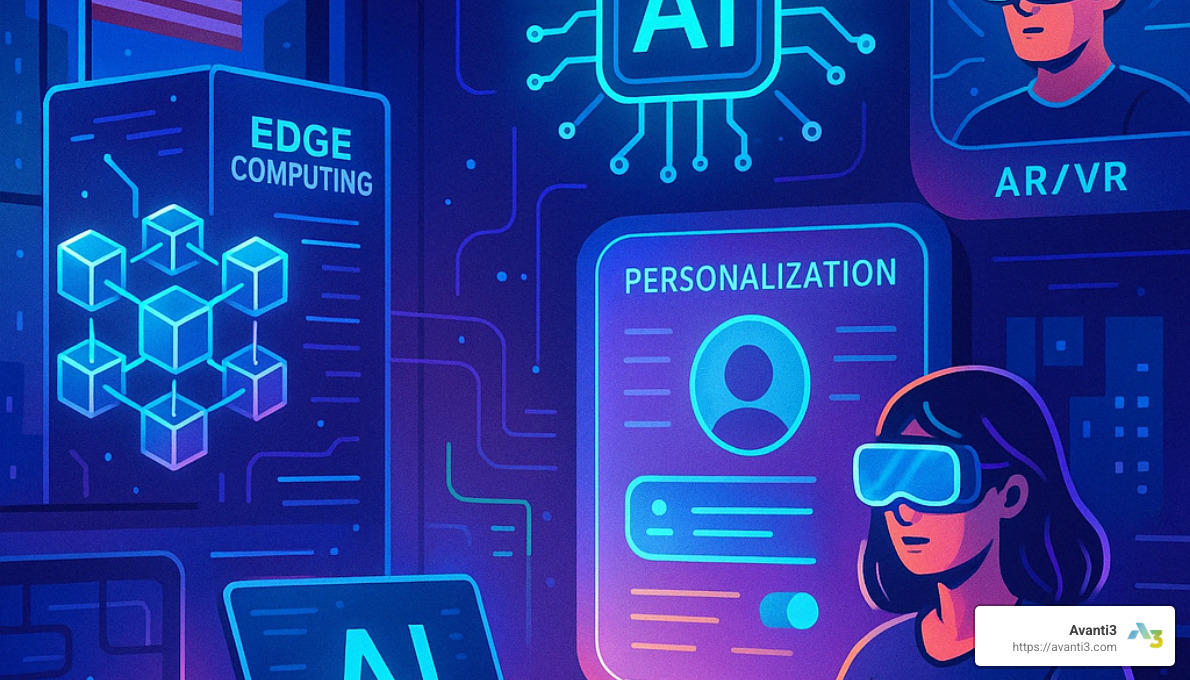
The Future of AI-Driven Personalization
Looking ahead, we expect AI-driven personalization to become increasingly predictive, anticipating customers’ needs even before they consciously realize them. Personalization will also become invisible, blending naturally into the experience without feeling intrusive or overly obvious.
Personalization will become deeply contextual, adapting seamlessly to the user’s time, location, and situation. Imagine your favorite coffee shop app automatically suggesting your usual order exactly as you approach the store, at your typical morning coffee time.
AI systems will also become more emotionally intelligent, recognizing and responding to customers’ emotions and sentiments. This emotional personalization can foster even deeper customer bonds, enhancing loyalty and satisfaction.
Finally, personalization will increasingly leverage collaborative insights, learning from collective behaviors while still respecting each person’s individuality and privacy. By 2024, research suggests roughly 75% of marketing operations will accept hyper-personalization using AI, highlighting just how quickly this technology is becoming standard practice across industries.
At Avanti3, we’re excited to empower brands and creators with innovative personalization tools that blend the best of AI, blockchain, and immersive technologies. We’re setting a new standard for what’s possible, helping you deliver personalized experiences that are secure, transparent—and truly remarkable.
Frequently Asked Questions about AI-Driven Personalization
What is AI-Driven Personalization and How Does It Work?
AI-driven personalization is all about using artificial intelligence (AI) to give people experiences custom just for them. But how does it actually work behind the scenes?
It starts with collecting and analyzing customer data—this can include things like browsing history, past purchases, clicking habits, even what device someone uses. AI systems then take this data and use clever algorithms to spot patterns and preferences that make each person unique.
Once the AI understands these patterns, it delivers personalized experiences—things like customized content, product suggestions, or special offers—that feel like they’re made just for you. And the best part? AI-driven personalization doesn’t stop learning. With every new interaction, it keeps refining its insights, consistently making the experience better and more relevant.
How Can Businesses Get Started with AI Personalization?
Getting started with AI-driven personalization doesn’t have to feel overwhelming—it’s all about taking the right steps.
First, take a good look at the data you’re already collecting. Do you have enough information about your customers’ behavior and preferences? Where are the gaps?
Next, you’ll want to set clear objectives. Whether you want to increase conversions, improve customer satisfaction, or boost retention, a clear goal will guide your strategy. Always start small—focusing first on something manageable like email recommendations or homepage content personalization.
Now, it’s time to select your tech. Look for AI personalization tools that match your business needs, your existing tech stack, and your team’s capabilities. Then set up a solid way to measure success, tracking things like conversion rates, average order value, engagement metrics, or customer satisfaction scores.
Don’t go it alone, either—build a cross-functional team including marketing experts, IT specialists, data scientists, and customer service reps. This ensures everyone is aligned and working towards shared goals.
Finally, create a clear roadmap outlining each step of implementation. As marketing expert James Brooks wisely pointed out: “Put the effort in upfront. A well-built AI personalization strategy will serve you every day, on autopilot, for months or even years.”
What Are the Ethical Considerations in AI Personalization?
With great personalization power comes great responsibility—and ethics matter a lot in AI-driven personalization. The most critical thing is protecting customer data privacy. Only gather data that’s absolutely necessary, store it securely, and handle it responsibly.
Transparency is also key. Let your customers know exactly how their data is being used to personalize their experiences, and always give them control. Allow them to adjust settings or even opt out entirely if they prefer.
You also need to watch out for discrimination—regularly check your AI systems for potential biases. Make sure personalization treats everyone fairly. AI should never exploit vulnerabilities or manipulate customers. Instead, use it to genuinely improve their experience.
At Avanti3, we believe strong ethics build lasting trust. That’s why we combine AI with blockchain technology—giving people clear control and transparency over their own data while delivering engaging, personalized experiences.
How Does AI Personalization Affect ROI?
The short answer? AI-driven personalization boosts ROI dramatically. Businesses using it have reported returns up to 800% on their marketing spend. Companies see between 5 to 8 times better results compared to traditional marketing methods.
Why does personalization have such a strong impact? It increases conversion rates because customers receive highly relevant offers. They’re more likely to buy when recommendations feel hand-picked for them. It also drives higher average order values through smarter cross-selling and upselling.
Personalization helps retain customers, too, because personalized interactions foster loyalty and emotional connections. It also means less wasted time and money—since you’re targeting audiences more effectively and not spending budget on irrelevant messaging.
Finally, it creates operational efficiencies. Automating personalization reduces manual efforts, freeing your team up to focus on strategic priorities rather than routine tasks.
How Can AI Personalization Be Applied to Different Marketing Channels?
The great thing about AI-driven personalization is that you’re not limited to just one marketing channel. It works brilliantly across email, websites, social media, mobile apps, and even customer service interactions.
Take email marketing, for example—AI can create personalized subject lines that boost open rates by 26%, or tailor dynamic content based on each customer’s preferences and browsing behavior. You can even schedule send times based on when each person is most likely to open their emails.
On your website, personalization gives each visitor a unique experience. Your homepage content can dynamically shift based on their interests, navigation paths can adjust to their behaviors, and product recommendations become highly targeted to their needs.
Social media benefits from AI, too. Personalized ad targeting, optimized posting times, and custom content feeds help boost engagement and conversions. AI can segment your audiences more effectively and deliver messages that resonate deeply with specific groups.
Mobile apps can use location-based personalization, offer custom push notifications, and adapt their user interfaces based on individual use patterns. This keeps users engaged and coming back for more.
Customer service channels also become more effective and personal. AI can suggest custom support solutions based on customer history, anticipate issues before they happen, and even respond based on each customer’s sentiment in real-time.
The bottom line: whether someone is checking their email, scrolling social feeds, browsing your website, or chatting with customer service, AI makes every interaction feel like it’s just for them.
Conclusion

AI-driven personalization has quickly transformed from a competitive edge into an essential part of doing business today. Throughout this guide, we’ve explored how this powerful technology allows brands to create truly unique experiences that customers love—driving genuine engagement, loyalty, and incredible business results.
We’ve seen how AI isn’t just about addressing customers by their first names in emails anymore. Instead, it deeply understands their preferences, predicts their needs, and adapts content dynamically—turning every interaction into a meaningful one-on-one conversation. This advanced approach consistently drives substantial business outcomes, including a remarkable 800% ROI on marketing spend and conversion rate increases of 10-30%.
One thing we’ve finded is that the benefits of AI-driven personalization aren’t limited to just one industry. Whether it’s e-commerce sites offering spot-on product recommendations or healthcare providers tailoring patient experiences, entertainment companies customizing streaming content, or finance firms delivering personalized financial advice, AI personalization boosts performance across the board.
Of course, implementing AI isn’t without its challenges. Businesses must thoughtfully address critical issues around data privacy, ensuring compliance with GDPR and similar regulations. They also need to overcome technical complexities, such as integrating AI systems with existing technology stacks and managing real-time data processing. Ethical considerations also play a significant role—brands must uphold transparency, offer clear consent options, and avoid over-personalizing in ways that could feel intrusive.
Looking ahead, the future of AI-driven personalization promises even more exciting possibilities. Emerging technologies like generative AI will enable hyper-personalization, creating completely customized content experiences for each individual. Omnichannel personalization will seamlessly connect customer journeys across devices, physical locations, and digital spaces. Additionally, technologies like blockchain will improve data security, giving customers true ownership and control over their personal information.
At Avanti3, we’re proud to be at the forefront of this exciting future. By integrating cutting-edge Web3 technologies—blockchain, NFTs, and immersive AR/VR experiences—with leading-edge AI personalization, we help creators and brands build deeper, more meaningful connections with their audiences. Our platform allows businesses to deliver highly personalized, engaging experiences while fully respecting user privacy and data ownership.
The future of customer experience is personalized, predictive, and privacy-conscious. By embracing AI-driven personalization, businesses can deliver experiences that feel truly personal—making customers feel understood, valued, and connected.
To learn more about how Avanti3 can empower your brand through innovative, AI-driven experiences, visit our AI Customer Engagement page.
Remember the wise words of marketing expert Lauren Petrullo: “The personalization that you can leverage with AI allows the consumer or the subscriber to feel like you’re talking to them one-on-one versus one-to-many.” That personal touch, delivered at scale, is exactly what makes AI-driven personalization so powerful—and why it’s the future of customer experiences.







